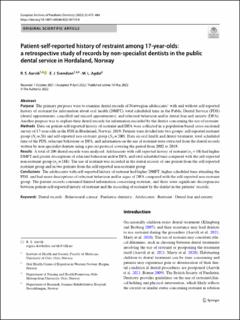| dc.contributor.author | Aarvik, Regina Skavhellen | |
| dc.contributor.author | Svendsen, Edel Jannecke | |
| dc.contributor.author | Agdal, Maren Gry Lillehaug | |
| dc.date.accessioned | 2023-02-20T14:25:50Z | |
| dc.date.available | 2023-02-20T14:25:50Z | |
| dc.date.created | 2022-10-13T21:14:43Z | |
| dc.date.issued | 2022-05-10 | |
| dc.identifier.citation | European Archives of Paediatric Dentistry. 2022, 23 (3), 475-484. | en_US |
| dc.identifier.issn | 1818-6300 | |
| dc.identifier.issn | 1996-9805 | |
| dc.identifier.uri | https://hdl.handle.net/11250/3052445 | |
| dc.description.abstract | Purpose: The primary purposes were to examine dental records of Norwegian adolescents’ with and without self-reported history of restraint for information about oral health (DMFT), total scheduled time in the Public Dental Service (PDS) (dental appointments, cancelled and missed appointments), and reluctant behaviour and/or dental fear and anxiety (DFA). Another purpose was to explore their dental records for information recorded by the dentist concerning the use of restraint.
Methods: Data on patient-self-reported history of restraint and DFA were collected in a population-based cross-sectional survey of 17-year-olds in the PDS in Hordaland, Norway, 2019. Patients were divided into two groups: self-reported restraint group (N1 = 26) and self-reported non-restraint group (N2 = 200). Data on oral health and dental treatment, total scheduled time of the PDS, reluctant behaviour or DFA, and information on the use of restraint were extracted from the dental records written by non-specialist dentists using a pre-set protocol covering the period from 2002 to 2019.
Results: A total of 206 dental records were analysed. Adolescents with self-reported history of restraint (n1 = 18) had higher DMFT and greater descriptions of reluctant behaviour and/or DFA, and total scheduled time compared with the self-reported non-restraint group (n2 = 188). The use of restraint was recorded in the dental records of one patient from the self-reported restraint group and in two patients from the self-reported non-restraint group.
Conclusions: The adolescents with self-reported history of restraint had higher DMFT, higher scheduled time attending the PDS, and had more descriptions of reluctant behaviour and/or signs of DFA compared with the self-reported non-restraint group. The patient records contained limited information concerning restraint, and there were significant discrepancies between patient-self-reported history of restraint and the recording of restraint by the dentist in the patients’ records. | en_US |
| dc.language.iso | eng | en_US |
| dc.publisher | Springer | en_US |
| dc.relation.ispartofseries | European Archives of Paediatric Dentistry;Volume 23, issue 3 | |
| dc.rights | Navngivelse 4.0 Internasjonal | * |
| dc.rights.uri | http://creativecommons.org/licenses/by/4.0/deed.no | * |
| dc.title | Patient-self-reported history of restraint among 17-year-olds: a retrospective study of records by non-specialist dentists in the public dental service in Hordaland, Norway | en_US |
| dc.type | Peer reviewed | en_US |
| dc.type | Journal article | en_US |
| dc.description.version | publishedVersion | en_US |
| dc.rights.holder | © The Author(s) 2022 | en_US |
| cristin.ispublished | true | |
| cristin.fulltext | original | |
| cristin.qualitycode | 1 | |
| dc.identifier.doi | https://doi.org/10.1007/s40368-022-00710-0 | |
| dc.identifier.cristin | 2061330 | |
| dc.source.journal | European Archives of Paediatric Dentistry | en_US |
| dc.source.volume | 23 | en_US |
| dc.source.issue | 3 | en_US |
| dc.source.pagenumber | 475-484 | en_US |

